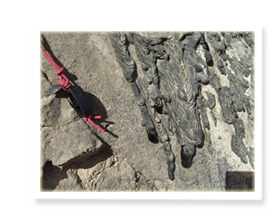RESEARCH
The continuous thread that runs through my research program is the concept of Tectonic Inheritance - the idea that pre-existing weaknesses in the crust form the loci for development of later tectonic features - major faults, folds and the associated variations in depositional environment and sedimentation patterns. This concept becomes crucial for understanding areas with complex and prolonged geologic histories. Past research projects have covered the Zagros Folded Belt, the Persian Gulf and the Rocky Mountains. Current projects are listed below:
- Development of Triangle Zones at the deformation front of fold-thrust belts
 The aim of this project is to understand the mechanism of formation of triangle zones,
using data from exploration wells, field studies and analog modelling work. PhD work led to
the development of a model for the triangle zone in a particular region of the Rocky Mountains and this project aims to look at additional areas and possible controlling factors.
The aim of this project is to understand the mechanism of formation of triangle zones,
using data from exploration wells, field studies and analog modelling work. PhD work led to
the development of a model for the triangle zone in a particular region of the Rocky Mountains and this project aims to look at additional areas and possible controlling factors. - Development of arcuate fold-thrust belts
The aim of this work is to add to the understanding of arcuate belts, looking at transport directions of thrusts within the Sawtooth Range, Montana. Once suitable sites for fieldwork have been identified using remote datasets, field investigations will record strain data across the arc, allowing the formation of this arcuate belt to be defined. - Structural and petroleum evolution of the Middle East

Currently I have a student working on a region within the Middle East. I have worked on the petroleum potential and structural evolution of regions within the Zagros Simply Folded Belt and this is an on-going interest of mine. A paper ion GeoArabia covers the analysis of structures near Mosul in the Kurdistan Region of Iraq and a paper in review considers the effects of the basement structures in the wider Kirkuk Embayment. Additional work includes mapping the Iranian part of the Makran Accretionary Prism and investigating Karst structures in the Persian Gulf, using seimsic data. - Detecting the effects of early layer-parallel shortening in thrust regions
I am working on a pilot project to find a way of measuring this effect. Results to date indicate that LPS is a continuous process throughout the deformation sequence and that LPS amount is variable in space - highest near the base of the sedimentary pile in the hinterland, for example. Ongoing work looks at ways to calibrate field data to more general results from analog models. - Tectonic evolution of the mid-continent
Specifically, the area of interest is SE Nebraska and N Kansas, covering the Midcontinent Rift, the Nemaha Uplift and additional enigmatic structures within this zone. Research includes analog models, remote sensing data and field data. Multiple episodes of reactivation have influenced this area, despite the location far from any plate boundaries. - Fracture network characterization
Fracture networks are being analyzed in several regions across the USA, related to lithological change, diagenetic processes, mechanical variation in the sediment pile and overall connectivity issues. This work will contribute to the literature on predicting subsurface fracture networks for use in the hydrocarbon and hydrogeology fields.